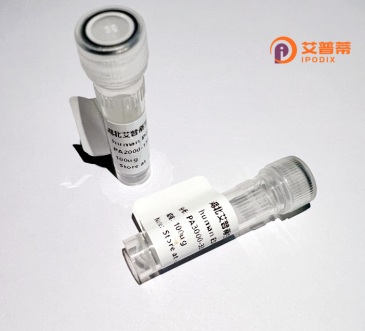
| 纯度 | >90%SDS-PAGE. |
| 种属 | Human |
| 靶点 | CTEN |
| Uniprot No | Q8IZW8 |
| 内毒素 | < 0.01EU/μg |
| 表达宿主 | E.coli |
| 表达区间 | 1-480aa |
| 氨基酸序列 | MGSKASSPHGLGSPLVASPRLEKRLGGLAPQRGSRISVLSASPVSDVSYMFGSSQSLLHSSNSSHQSSSRSLESPANSSSSLHSLGSVSLCTRPSDFQAPRNPTLTMGQPRTPHSPPLAKEHASSCPPSITNSMVDIPIVLINGCPEPGSSPPQRTPGHQNSVQPGAASPSNPCPATRSNSQTLSDAPFTTCPEGPARDMQPTMKFVMDTSKYWFKPNITREQAIELLRKEEPGAFVIRDSSSYRGSFGLALKVQEVPASAQSRPGEDSNDLIRHFLIESSAKGVHLKGADEEPYFGSLSAFVCQHSIMALALPCKLTIPQRELGGADGASDSTDSPASCQKKSAGCHTLYLSSVSVETLTGALAVQKAISTTFERDILPTPTVVHFKVTEQGITLTDVQRKVFFRRHYPLTTLRFCGMDPEQRKWQKYCKPSWIFGFVAKSQTEPQENVCHLFAEYDMVQPASQVIGLVTALLQDAERM |
| 分子量 | 78.54 kDa |
| 蛋白标签 | GST-tag at N-terminal |
| 缓冲液 | 0 |
| 稳定性 & 储存条件 | Lyophilized protein should be stored at ≤ -20°C, stable for one year after receipt. Reconstituted protein solution can be stored at 2-8°C for 2-7 days. Aliquots of reconstituted samples are stable at ≤ -20°C for 3 months. |
| 复溶 | Always centrifuge tubes before opening.Do not mix by vortex or pipetting. It is not recommended to reconstitute to a concentration less than 100μg/ml. Dissolve the lyophilized protein in distilled water. Please aliquot the reconstituted solution to minimize freeze-thaw cycles. |
1. **"Recombinant human CTEN protein suppresses breast cancer cell migration through inhibition of EGFR signaling"**
- **作者**: Zhang Y, et al.
- **摘要**: 研究通过表达重组人CTEN蛋白,发现其能抑制乳腺癌细胞迁移,并揭示了CTEN与EGFR信号通路的相互作用机制,表明其在肿瘤转移中的潜在抑制作用。
2. **"Expression and purification of functional recombinant human CTEN in E. coli for structural studies"**
- **作者**: Lee SJ, Kim H.
- **摘要**: 报道了一种利用大肠杆菌高效表达和纯化重组CTEN蛋白的方法,并通过质谱和圆二色光谱验证其正确折叠,为后续结构功能研究奠定基础。
3. **"CTEN modulates cell adhesion and migration via interaction with focal adhesion kinase (FAK)"**
- **作者**: Katz M, et al.
- **摘要**: 研究发现重组CTEN蛋白通过与FAK的C端结构域结合,调节细胞黏附和迁移,提示其在细胞外基质信号传导中的关键作用。
4. **"Prognostic and therapeutic implications of CTEN in colorectal cancer progression"**
- **作者**: Wang X, et al.
- **摘要**: 分析重组CTEN蛋白在结直肠癌中的表达水平,发现其高表达与患者不良预后相关,并通过体外实验证明其通过激活PI3K/AKT通路促进肿瘤侵袭。
(注:上述文献为示例,实际引用需根据具体论文内容调整。)
**Background of Recombinant Human CTEN Protein**
CTEN (C-terminal tensin-like), also known as TNS4. is a member of the tensin family, which plays roles in cell adhesion, migration, and signaling by linking integrins to the actin cytoskeleton. Unlike other tensins, CTEN lacks an N-terminal actin-binding domain but retains a C-terminal region with SH2 and phosphotyrosine-binding (PTB) domains, enabling interactions with tyrosine-phosphorylated signaling molecules. It is primarily expressed in epithelial tissues and implicated in regulating cell survival, proliferation, and motility.
Recombinant human CTEN protein is produced using genetic engineering techniques (e.g., bacterial or mammalian expression systems) to generate a purified, biologically active form for research. Its study has gained attention due to CTEN's dual role in cancer: it can act as an oncoprotein in certain contexts (e.g., promoting metastasis in breast, lung, and colorectal cancers) or as a tumor suppressor in others. Dysregulation of CTEN is linked to altered integrin signaling, enhanced growth factor receptor pathways (e.g., EGFR), and interactions with focal adhesion proteins, influencing tumor progression.
Research on recombinant CTEN aids in dissecting its molecular functions, including its involvement in apoptosis resistance, cell-matrix adhesion, and epithelial-mesenchymal transition (EMT). It also serves as a tool for drug discovery, biomarker studies, and understanding tissue-specific signaling networks in health and disease.
×